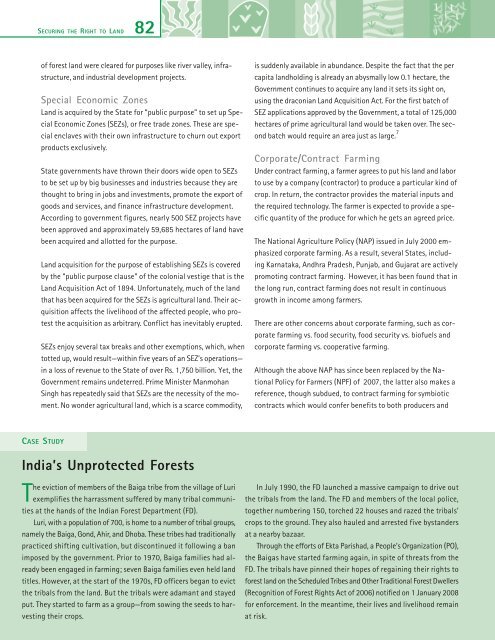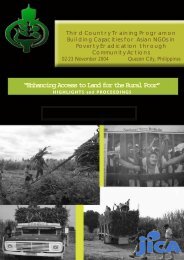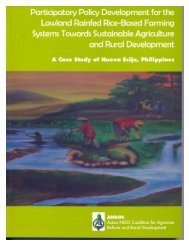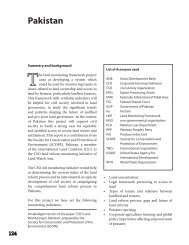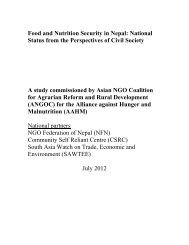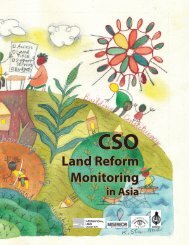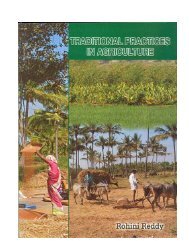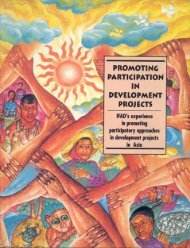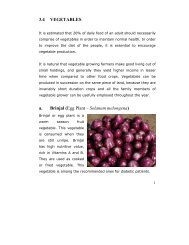Securing the Right to Land FULL - ANGOC
Securing the Right to Land FULL - ANGOC
Securing the Right to Land FULL - ANGOC
You also want an ePaper? Increase the reach of your titles
YUMPU automatically turns print PDFs into web optimized ePapers that Google loves.
SECURING THE RIGHT TO LAND<br />
82<br />
of forest land were cleared for purposes like river valley, infrastructure,<br />
and industrial development projects.<br />
Special Economic Zones<br />
<strong>Land</strong> is acquired by <strong>the</strong> State for “public purpose” <strong>to</strong> set up Spe-<br />
cial Economic Zones (SEZs), or free trade zones. These are special<br />
enclaves with <strong>the</strong>ir own infrastructure <strong>to</strong> churn out export<br />
products exclusively.<br />
State governments have thrown <strong>the</strong>ir doors wide open <strong>to</strong> SEZs<br />
<strong>to</strong> be set up by big businesses and industries because <strong>the</strong>y are<br />
thought <strong>to</strong> bring in jobs and investments, promote <strong>the</strong> export of<br />
goods and services, and finance infrastructure development.<br />
According <strong>to</strong> government figures, nearly 500 SEZ projects have<br />
been approved and approximately 59,685 hectares of land have<br />
been acquired and allotted for <strong>the</strong> purpose.<br />
<strong>Land</strong> acquisition for <strong>the</strong> purpose of establishing SEZs is covered<br />
by <strong>the</strong> “public purpose clause” of <strong>the</strong> colonial vestige that is <strong>the</strong><br />
<strong>Land</strong> Acquisition Act of 1894. Unfortunately, much of <strong>the</strong> land<br />
that has been acquired for <strong>the</strong> SEZs is agricultural land. Their acquisition<br />
affects <strong>the</strong> livelihood of <strong>the</strong> affected people, who protest<br />
<strong>the</strong> acquisition as arbitrary. Conflict has inevitably erupted.<br />
SEZs enjoy several tax breaks and o<strong>the</strong>r exemptions, which, when<br />
<strong>to</strong>tted up, would result—within five years of an SEZ’s operations—<br />
in a loss of revenue <strong>to</strong> <strong>the</strong> State of over Rs. 1,750 billion. Yet, <strong>the</strong><br />
Government remains undeterred. Prime Minister Manmohan<br />
Singh has repeatedly said that SEZs are <strong>the</strong> necessity of <strong>the</strong> moment.<br />
No wonder agricultural land, which is a scarce commodity,<br />
CASE STUDY<br />
India’s Unprotected Forests<br />
The eviction of members of <strong>the</strong> Baiga tribe from <strong>the</strong> village of Luri<br />
exemplifies <strong>the</strong> harrassment suffered by many tribal communities<br />
at <strong>the</strong> hands of <strong>the</strong> Indian Forest Department (FD).<br />
Luri, with a population of 700, is home <strong>to</strong> a number of tribal groups,<br />
namely <strong>the</strong> Baiga, Gond, Ahir, and Dhoba. These tribes had traditionally<br />
practiced shifting cultivation, but discontinued it following a ban<br />
imposed by <strong>the</strong> government. Prior <strong>to</strong> 1970, Baiga families had already<br />
been engaged in farming; seven Baiga families even held land<br />
titles. However, at <strong>the</strong> start of <strong>the</strong> 1970s, FD officers began <strong>to</strong> evict<br />
<strong>the</strong> tribals from <strong>the</strong> land. But <strong>the</strong> tribals were adamant and stayed<br />
put. They started <strong>to</strong> farm as a group—from sowing <strong>the</strong> seeds <strong>to</strong> harvesting<br />
<strong>the</strong>ir crops.<br />
is suddenly available in abundance. Despite <strong>the</strong> fact that <strong>the</strong> per<br />
capita landholding is already an abysmally low 0.1 hectare, <strong>the</strong><br />
Government continues <strong>to</strong> acquire any land it sets its sight on,<br />
using <strong>the</strong> draconian <strong>Land</strong> Acquisition Act. For <strong>the</strong> first batch of<br />
SEZ applications approved by <strong>the</strong> Government, a <strong>to</strong>tal of 125,000<br />
hectares of prime agricultural land would be taken over. The second<br />
batch would require an area just as large. 7<br />
Corporate/Contract Farming<br />
Under contract farming, a farmer agrees <strong>to</strong> put his land and labor<br />
<strong>to</strong> use by a company (contrac<strong>to</strong>r) <strong>to</strong> produce a particular kind of<br />
crop. In return, <strong>the</strong> contrac<strong>to</strong>r provides <strong>the</strong> material inputs and<br />
<strong>the</strong> required technology. The farmer is expected <strong>to</strong> provide a specific<br />
quantity of <strong>the</strong> produce for which he gets an agreed price.<br />
The National Agriculture Policy (NAP) issued in July 2000 emphasized<br />
corporate farming. As a result, several States, including<br />
Karnataka, Andhra Pradesh, Punjab, and Gujarat are actively<br />
promoting contract farming. However, it has been found that in<br />
<strong>the</strong> long run, contract farming does not result in continuous<br />
growth in income among farmers.<br />
There are o<strong>the</strong>r concerns about corporate farming, such as corporate<br />
farming vs. food security, food security vs. biofuels and<br />
corporate farming vs. cooperative farming.<br />
Although <strong>the</strong> above NAP has since been replaced by <strong>the</strong> National<br />
Policy for Farmers (NPF) of 2007, <strong>the</strong> latter also makes a<br />
reference, though subdued, <strong>to</strong> contract farming for symbiotic<br />
contracts which would confer benefits <strong>to</strong> both producers and<br />
In July 1990, <strong>the</strong> FD launched a massive campaign <strong>to</strong> drive out<br />
<strong>the</strong> tribals from <strong>the</strong> land. The FD and members of <strong>the</strong> local police,<br />
<strong>to</strong>ge<strong>the</strong>r numbering 150, <strong>to</strong>rched 22 houses and razed <strong>the</strong> tribals’<br />
crops <strong>to</strong> <strong>the</strong> ground. They also hauled and arrested five bystanders<br />
at a nearby bazaar.<br />
Through <strong>the</strong> efforts of Ekta Parishad, a People’s Organization (PO),<br />
<strong>the</strong> Baigas have started farming again, in spite of threats from <strong>the</strong><br />
FD. The tribals have pinned <strong>the</strong>ir hopes of regaining <strong>the</strong>ir rights <strong>to</strong><br />
forest land on <strong>the</strong> Scheduled Tribes and O<strong>the</strong>r Traditional Forest Dwellers<br />
(Recognition of Forest <strong>Right</strong>s Act of 2006) notified on 1 January 2008<br />
for enforcement. In <strong>the</strong> meantime, <strong>the</strong>ir lives and livelihood remain<br />
at risk.


